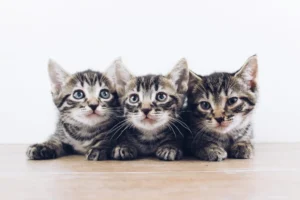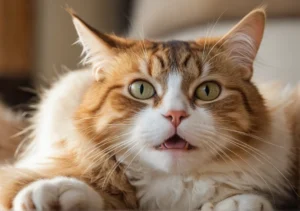Cats are fascinating creatures with a myriad of behaviors that can leave us both amused and perplexed. One common behavior that many cat owners have likely experienced is the combination of purring and nipping. But why do cats nip when they are purring? Let’s uncover the reasons behind this intriguing feline behavior.
The Instinctual Connection Between Purring and Nipping
Have you ever noticed your cat nipping at you while they’re purring contently in your lap? This behavior might seem contradictory at first, but there’s actually an instinctual connection between purring and nipping in cats.
Cats are natural hunters , and their instincts play a significant role in their behavior, even in domestic settings. When a cat purrs, it signifies a state of relaxation and contentment. However, nipping is also a way for cats to establish boundaries and communicate their needs.
Nipping can be a manifestation of excitement during petting or playtime. It’s their way of expressing enthusiasm and engaging in playful behavior. When a cat nips lightly, it’s usually a gentle reminder that they’re enjoying the interaction but might need a break or a change in activity.
Additionally, nipping can be a form of asserting dominance or control. Cats have a hierarchy within their social structure, and nipping can be a way for them to demonstrate their position. This behavior is more common in multi-cat households where cats need to establish their roles within the group.
Understanding this instinctual connection between purring and nipping can help you interpret your cat’s behavior better and respond appropriately. By recognizing the subtle cues they give, you can strengthen your bond with your feline friend and ensure a harmonious relationship.
Communication Through Touch
Cats are masters of communication, using a variety of vocalizations, body language, and touch to convey their feelings and needs. When it comes to nipping, cats often use this physical gesture as a form of communication, especially when paired with their purring.
Nipping can be a way for cats to express affection and intimacy. It’s their version of a gentle “love bite” to show their affection towards their human or feline companions. This behavior is more common during moments of bonding and closeness, such as cuddle sessions or grooming.
It can also be a way for cats to communicate discomfort or overstimulation. If your cat nips suddenly during petting or play, it could be a sign that they’ve had enough and need a break. Pay attention to their body language and respect their boundaries to maintain a positive interaction.
In some cases, nipping can serve as a form of play . Cats have a natural instinct to play-fight, and nipping can be a part of their playful interactions. It’s important to distinguish between playful nipping and aggressive behavior to ensure a safe and enjoyable playtime for both you and your cat.
By understanding how cats use nipping as a form of communication, you can better interpret their behavior and strengthen your bond with your feline companion. Paying attention to their cues and responding appropriately will help nurture a healthy and fulfilling relationship with your furry friend.
Playful Behavior or Something More?
Have you ever wondered why your cat sometimes nips at you while purring? It’s essential to understand that this behavior can have multiple meanings. While it may simply be a playful gesture for some cats, it can also be a sign of overstimulation or a way for your feline friend to set boundaries.
Cats are known for their playful nature, and nipping can sometimes be their way of engaging with you during a purring session. However, it’s crucial to pay attention to your cat’s body language and the context in which the nipping occurs. If your cat seems relaxed and content, it’s likely just a playful behavior.
On the other hand, if your cat’s nipping is accompanied by flattened ears, dilated pupils, or other signs of discomfort, it may be a signal that they are feeling overstimulated or anxious. In such cases, it’s essential to respect your cat’s boundaries and give them space to relax.
Setting aside time for interactive play sessions with appropriate toys can help redirect your cat’s nipping behavior in a positive way. By providing enrichment and physical activity, you can help your feline companion release excess energy in a more appropriate manner.
Remember, every cat is unique, so understanding your cat’s individual preferences and behaviors is key to fostering a harmonious and fulfilling relationship. By observing your cat’s cues and responding appropriately, you can strengthen your bond and create a happy and healthy environment for both of you.
Setting Boundaries with Your Cat
Establishing boundaries with your cat is crucial for maintaining a respectful and trusting relationship. When it comes to nipping behavior during purring, it’s essential to communicate clearly and consistently with your feline companion.
One effective strategy is to use positive reinforcement to encourage desirable behavior. For example, when your cat engages in gentle play without nipping, reward them with treats or praise. This helps reinforce the behavior you want to see more of and encourages mutual respect.
If your cat nips during purring, avoid reacting with loud noises or punishment, as this can escalate the situation and lead to further stress. Instead, gently remove yourself from the interaction and give your cat time to calm down.
Additionally, providing your cat with a designated space where they can retreat and relax can help prevent nipping behavior. Cats appreciate having a safe and quiet area where they can unwind and recharge, so make sure to set up a cozy spot just for them.
By setting clear boundaries, using positive reinforcement, and being attentive to your cat’s needs, you can cultivate a strong and healthy relationship based on trust and understanding.
Extra tip: Remember that consistent training and positive reinforcement are key to addressing nipping behavior effectively. By being patient and understanding, you can help your cat learn appropriate ways to interact with you during purring sessions.
Addressing Potential Aggression
Have you ever wondered why your cat nips at you while purring? Sometimes, this behavior can be a sign of aggression, but not always. It’s essential to pay attention to your cat’s body language. If their ears are back, pupils dilated, or they are growling, it might be a sign of aggression. On the other hand, if your cat is relaxed, with ears forward and a relaxed body posture, it’s more likely playful behavior.
To address potential aggression, it’s vital to establish boundaries with your cat. Make sure to provide them with plenty of hiding spots, scratching posts, and toys to channel their energy. If you notice aggressive behavior, give them space and avoid punishment, as it can escalate the situation. Consulting with a veterinarian or animal behaviorist can also provide valuable insights into addressing aggression in cats.
Providing Enrichment and Stimulation
Cats are intelligent and curious creatures that thrive on mental stimulation. If your cat is nipping while purring, it could be a sign of boredom. To prevent this behavior, provide your furry friend with a variety of toys, scratching posts, and interactive games. Rotating toys regularly can keep things exciting and prevent boredom.
In addition to toys, consider creating a stimulating environment for your cat. This could include puzzle feeders, cat trees, or even a window perch for bird watching. Providing opportunities for play and exploration can help keep your cat engaged and reduce the likelihood of nipping behavior during purring.
Additional Insight:
Consider incorporating vertical space into your cat’s environment. Cats love to climb and perch in high places, so investing in a cat tree or shelves can offer additional enrichment and mental stimulation for your feline friend.
Consultation with a Veterinarian or Behaviorist
If you notice your cat nipping while purring and are concerned about this behavior, it’s essential to seek professional advice. Consulting with a veterinarian or behaviorist can help you understand the root cause of this behavior and how to address it effectively. These experts can provide personalized guidance tailored to your cat’s specific needs, ensuring a healthy and harmonious relationship between you and your feline companion.
When it comes to cat behavior, every cat is unique, and what works for one cat may not work for another. By seeking professional advice, you can gain valuable insights into your cat’s behavior and develop a tailored approach to managing nipping during purring. Remember, a little professional guidance can go a long way in ensuring your cat’s well-being and happiness.
So, if you’re unsure about your cat’s nipping behavior during purring, don’t hesitate to reach out to a veterinarian or behaviorist for expert assistance. Your cat’s well-being is worth the investment in professional advice and guidance!
Understanding Your Cat’s Body Language
When your cat nips while purring, it can be a form of communication. Cats use body language to express their emotions and needs, and nipping during purring may be their way of showing affection or excitement. By paying attention to your cat’s body language, you can better understand what they are trying to communicate.
Here are some common cat body language cues to look out for:
- Ears held back: Indicates fear or aggression.
- Tail twitching: Shows that the cat is agitated or overstimulated.
- Purring: Can signify contentment or happiness.
- Slow blinking: A sign of trust and relaxation.
By learning to read your cat’s body language, you can decipher the messages they are trying to convey. This understanding can help you respond appropriately to your cat’s needs and strengthen the bond between you and your feline friend.
Alex, a passionate animal lover, has experience in training and understanding animal behavior. As a proud pet parent to two dogs and three cats, he founded AnimalReport.net to share insights from animal experts and expand his knowledge of the animal kingdom.




